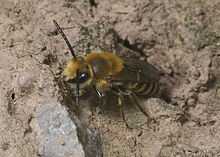Colletes hederae
| Colletes hederae | |
|---|---|
 | |
| Scientific classification | |
| Kingdom: | Animalia |
| Phylum: | Arthropoda |
| Class: | Insecta |
| Order: | Hymenoptera |
| Family: | Colletidae |
| Genus: | Colletes |
| Species: | C. hederae |
| Binomial name | |
| Colletes hederae Schmidt & Westrich, 1993 | |
Colletes hederae, the Ivy Bee, is a species of plasterer bee belonging to the family Colletidae subfamily Colletinae.
These mining bees are known from Austria, Belgium, Channel Islands, Croatia, Cyprus, southern England, France, Germany, Greece, Italy, Luxembourg, Netherlands, Serbia, Slovenia, Spain and Switzerland.[1][2]
They have been only recently described (Schmidt & Westrich 1993) as a distinct species. Until then, they were confused with another species of Colletes the morphologically very similar Colletes halophilus.
The thorax of the adults is covered by orange-brown hair, while each abdominal segment has an apical orangey hair-band. The females are on average 13 millimetres (0.51 in) long, while the males are about 10 mm (0.39 in) long.
The adults emerge late in the year (the males from late August and the females a little later in early September) and remain on the wing until early November. The principal pollen forage plant is Ivy (Hedera helix) (hence the specific epithet hederae), but both sexes will also nectar at Ivy flowers too. When Ivy is scarce, other species of plants are also visited. The females supply the larval brood almost cells exclusively with nectar and pollen of ivy flowers. When Ivy flowering is delayed, females may also collect pollen at various members of the Daisy family (Asteraceae).
These are solitary bees and do not live in colonies and do not overwinter as adults. They nest in clay-sandy soils, especially in loess hills and soft-rock cliffs. Like many other solitary bees, they can often be found nesting in dense aggregations, sometimes numbering many tens of thousands of nests. In parts of the west European range of the species, Colletes hederae are fequently parasitized by the larvae of the meloid beetle Stenoria analis, that feed on the supply of nectar and pollen prepared by females bees in their nests.
References
- ↑ "Fauna Europaea : Colletes hederaes". Retrieved 2012-11-06.
- ↑ "BWARS Information Sheet" (PDF). Retrieved 2012-11-06.
Bibliography
- Gogala, A., 1999. Bee Fauna of Slovenia: Checklist of species (Hymenoptera: Apoidea). Scopolia, 42: 1-79.
- Peeters, T.M.J., I.P. Raemakers & J. Smit, 1999. Voorlopige atlas van de Nederlandse bijen (Apidae). European Invertebrate Survey Nederland, Leiden, 230 pp.
- Schmidt, K., & Westrich, P. 1993. Colletes hederae n.sp., eine bisher unerkannte auf Efeu (Hedera) spezialisierte Bienenart (Hymenoptera: Apoidea). Entomol. Z. 103 (6) pp. 89–112.
- Schwarz, M., F. Gusenleitner, P. Westrich & H. Dathe, 1996. Katalog der Bienen Österreichs, Deutschlands und der Schweiz (Hymenoptera, Apidae). Entomofauna Suppl. 8: 1-398.
- Westrich, P., 2008. Flexibles Pollensammelverhalten der ansonsten streng oligolektischen Seidenbiene Colletes hederae Schmidt & Westrich (Hymenoptera: Apidae). Eucera, Heft 2: pp 17–30
- Vereecken N. J. & Mahé G., 2007. Larval aggregations of the blister beetle Stenoria analis (Schaum) (Coleoptera: Meloidae) sexually deceive patrolling males of their host, the solitary bee Colletes hederae Schmidt & Westrich (Hymenoptera: Colletidae). Annales de la Société Entomologique de France
External links
| Wikimedia Commons has media related to Colletes hederae. |